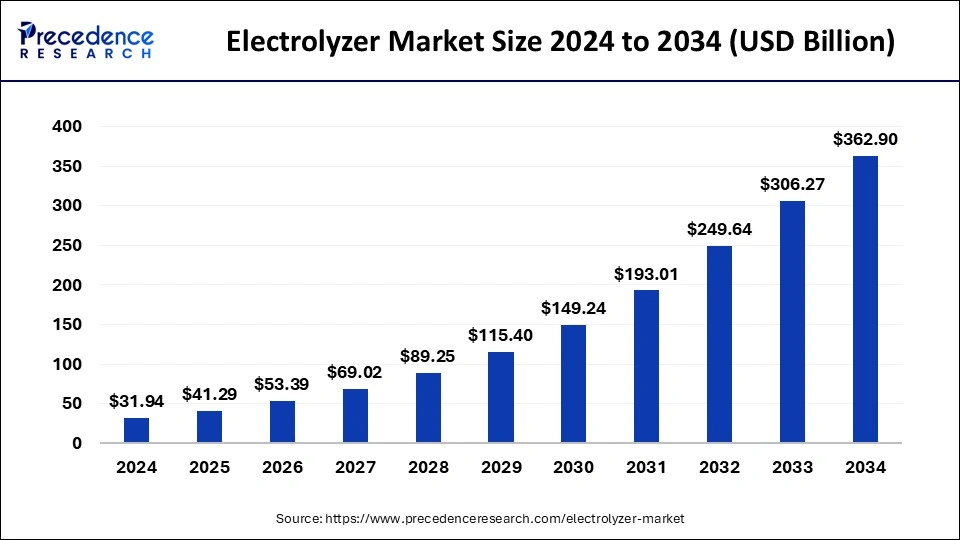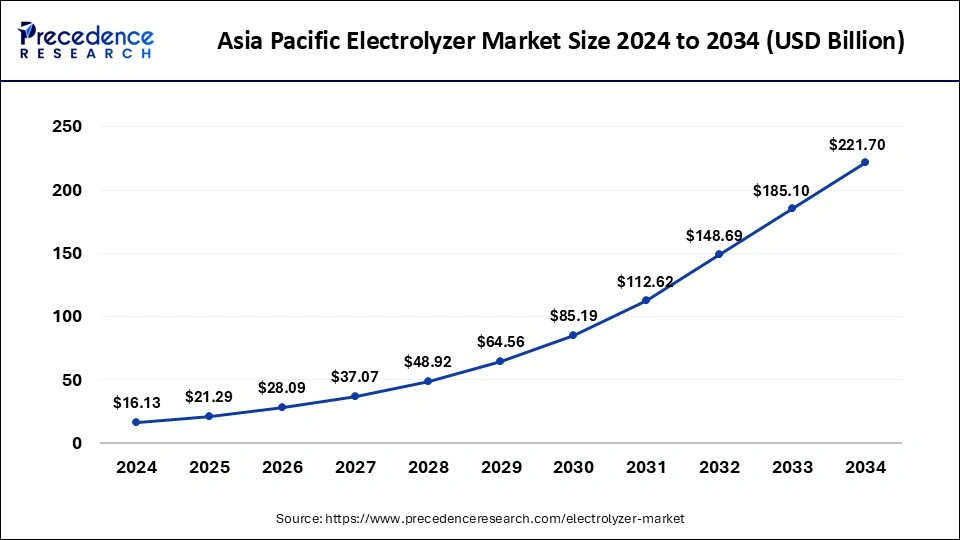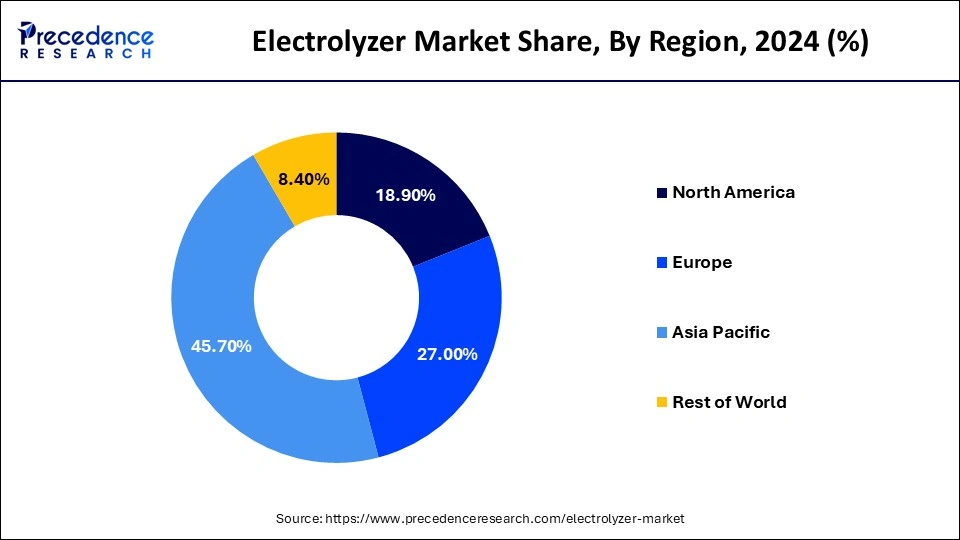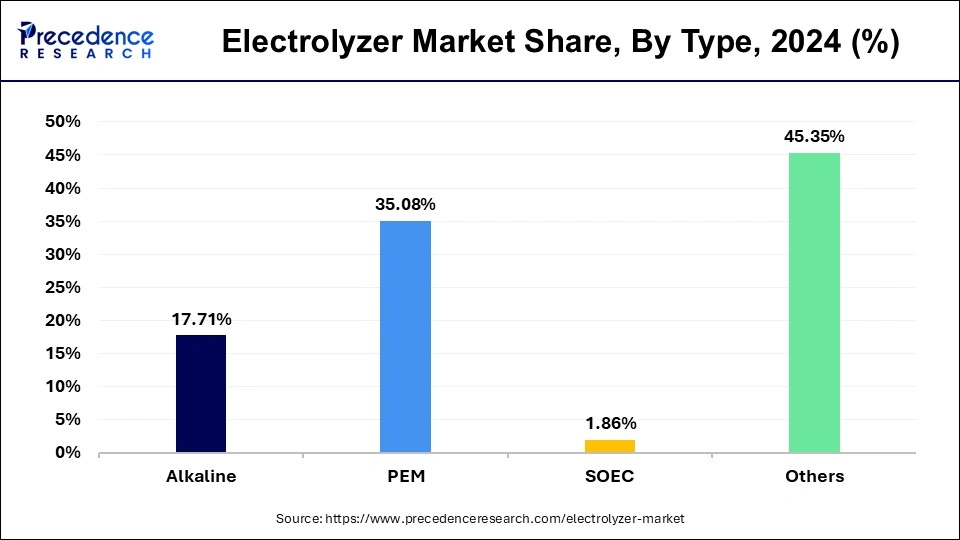List of Contents
Electrolyzer Market Size and Forecast 2025 to 2034
The global electrolyzer market size accounted for USD 31.94 billion in 2024 and is predicted to increase from USD 41.29 billion in 2025 to approximately USD 362.90 billion by 2034, expanding at a CAGR of 27.31% from 2025 to 2034.

Electrolyzer Market Key Takeaways
- By type, the PEM electrolyzer segment has contributed market share of 35.16% in 2024.
- By application, the mobility segment has garnered market share of 37.38% in 2024.
- By capacity, above 2 MW segment has reached 93.7% of total revenue share in 2024.
Role of AI in Electrolyzer Market
Artificial Intelligence (AI) is playing a key role in the dynamics of the electrolyzer market, allowing for smarter and more efficient generation of hydrogen. AI uses analytical data from multiple sources and optimizes the performance, energy consumption, and predictive maintenance of electrolyzers. AI enables control systems with the capability to respond dynamically to changing renewable energy inputs, which increases grid stability. AI-based algorithms will even enable researchers to see faster R&D times and assist with the next generation of PEM, alkaline, and solid oxide electrolyzers. As focus shifts toward green hydrogen, AI is steadily becoming a center point of cost effective, scalable, and smart electrolyzer systems and infrastructure, making it indispensable in clean energy future.
Asia Pacific Electrolyzer Market Size and Growth 2025 to 2034
The Asia Pacific electrolyzer market size was exhibited at USD 16.13 billion in 2024 and is projected to be worth around USD 221.70 billion by 2034, growing at a CAGR of 29.74% from 2025 to 2034.

On the basis of geography, the region of North America has emerged as the largest market for electrolyzers owing to the demand for various applications which deal with manufacturing processes. The power industry in this particular region also makes use of hydrogen on a large scale which helps the market to record a considerable revenue over the period of time. The active support of the infrastructure which is available for manufacturing in this particular region has emerged as a major contributor to the growth of the market. The region of North America has contributed considerably to the growth of the market owing to the rapid investment which has taken place in the field of refining, exploration and production which has in turn boosted the requirements for hydrogen gas on a large scale.

The huge number of investments which are made by the key market players in the region of Europe has helped the market to record a considerable revenue over the period of time. The availability of suitable infrastructure has supported the growth of the market considerably. The increasing demand for clean energy in the region of Asia Pacific has emerged as a major reason for the growth of the electrolyzer market. The increasing demand for clean fuel among the people has boosted the demand for hydrogen gas.
North America
North America continues to be a leader in the global electrolyzer market due partly to a favorable policy environment, industrial-scale hydrogen infrastructure development, and rising demand for clean forms of energy. The United States has been a key contributor, with an apparent commitment to clean hydrogen production delivered in national strategies, federal funding to establish hydrogen hubs, and alternative fuels tax credits found under the Inflation Reduction Act.
This strong support for clean hydrogen is quickly leading to investments in new advanced electrolyzer technologies and large-scale projects. Canada, while perhaps somewhat behind, is accelerating support for green hydrogen projects linking industrial decarbonization and energy storage.
The combined work in North America focusing on renewable energy integration, emissions reduction, and energy security must surely position it as an important platform for innovation, deployment activities and future growth in the global electrolyzer market and the hydrogen economy overall.
Europe
Europe is at the leading edge of the global electrolyzer market, bolstered by ambitious climate goals and solid hydrogen strategies supported by the European Union. As a result of the regions rapid growth in the deployment of electrolyzers spurred by REPowerEU and the European Hydrogen Strategy to reduce fossil fuel dependency and increase domestic hydrogen production, countries like Germany, France, Spain and the Netherlands are spearheading a hydrogen valley movement that emphasizes green hydrogen infrastructure.
For instance, large public funding through grants, extensive collaboration in research and private sector opportunities are speeding the way for large scale electrolyzer projects across industrial, mobility and power sector applications. The race to decarbonisation and innovation makes Europe a strong regional leader in moving electrolyzer technology forward and scaling clean hydrogen solutions sustainably.
Asia-Pacific
The Asia-Pacific region is rapidly evolving into the most dynamic region around the world within the electrolyzer market due to large government support, aggressive clean energy ambitions, and rapid industrialization. Countries such as China, Japan, South Korea and Australia are leading large-scale hydrogen production projects with national hydrogen strategies, and extensive investment from public and private capital. There is growing momentum for utility-scale and decentralized electrolyzer projects in the region as demand for green hydrogen in transportation, power and industries build up.
The influx of hydrogen spells further opportunities in the region with technology, renewable energy capacity and growing exports forecasting considerable growth in the electrolyzer markets. With an emphasis on domestic manufacturing, cost reductions, and innovation, Asia-Pacific is articulating a long-term hydrogen economy vision positioning its countries as global champions in electrolyzer technology development, infrastructure build-out, and long-term hydrogen economy leadership.
Market Overview
Growing rapidly, the electrolyzer market is witnessing strong expansion as organizations ramp up efforts to pivot toward clean and sustainable energy solutions. Electrolyzers are instrumental in creating green hydrogen (H2) by utilizing electricity, ideally from a renewable source to split water into hydrogen and oxygen. Electrolyzers will be essential to encourage the decarbonization of hard-to-abate industries such as energy, transport and heavy industry.
The continued moves towards net-zero, and improved technology in alkaline, PEM and solid oxide electrolyzers that improve efficiency and lower production costs, are important drivers of this market. Increasing investments into hydrogen infrastructure, and supportive government policies are adding further impetus to the market direction. As innovations improve scalability and manage grid- renewable integration, the electrolyzer market will solidify into critical features of the global clean energy pivot, representing a valuable area for long term growth.
Electrolyzer Market Growth Factors
- Demand for green hydrogen growing: Sustainable energy is becoming an increasingly important priority, driving the take-up of green hydrogen at large scale, which is driving uptake of electrolyzers.
- Government support and policy: Different regulations, grants and hydrogen roadmaps are driving investment in electrolyzer infrastructure.
- Improvement in electrolyzer technologies: Improvements in PEM, alkaline and solid oxide electrolysis learnings and technology are increasing efficiency, decreasing costs and allowing better scalability.
- Decarbonizing industrial sectors: The steel industry, ammonia, and refineries are shifting to hydrogen-based methods because of emissions goals.
- Hybridizations with renewable energy: Electrolyzers are now commonly hybridized with solar/ wind energy systems to take advantage of producing off-grid hydrogen in clean and efficient methods.
- Private-public partnerships: Partnerships, collaboratives, and global pilot projects are leading the way for investment in R&D, along with opening ways for market expansion.
Market Scope
| Report Coverage | Details |
| Market Size in 2025 | USD 41.29 Billion |
| Market Size by 2034 | USD 362.90 Billion |
| Growth Rate from 2025 to 2034 | CAGR of 27.31% |
| Base Year | 2024 |
| Forecast Period | 2025 to 2034 |
| Segments Covered | Type, Capacity, Application, and Geography |
| Regions Covered | North America, Europe, Asia-Pacific, Latin America, and Middle East & Africa |
Market Dynamics
Drivers
- Rapidly increasing investment - The increasing demand for hydrogen production and the various systems that help to store this energy has encouraged the key market players to make huge investments into this particular field. Countries such as Malaysia, India and Singapore have emerged as the major consumers who are striving to increase the production of hydrogen and its storage. The transportation industry in these regions have emerged as the major contributors to the growth of the market which is expected to continue in a similar fashion during the future as well.
- Fuel cell-based vehicles - increasing demand for vehicles that are operated with the help of hydrogen fuel cells has proved to be a major driving force for the market. The dependency over the traditional types of fuels has reduced comparatively which has proved to be a major growth factor for the market. People are switching to fuel cell vehicles instead of gasoline-based machines which is helping the market to record a considerable revenue over the period of time.
Challenges
- Increasing cost of electricity - the huge amount of electricity that is required for the process of electrolysis has imposed a major challenge over the growth of the electrolyzer market. The cost of electricity is increasing day by day which is imposing an additional pressure over the key market players. A sharp decline has been observed in the cost of the power which are generated from solar and wind. This has emerged as a major challenge to the growth of the electrolyzer market.
- Cheaper alternatives in the market - The existence of other options in the market which are cheaper as compared to the hydrogen fuel cells has proved to be a major restraining factor for the growth of the market.
Opportunities
- Increasing demand for electric vehicles - The rapid shift two electric vehicles from gasoline-based vehicles which has been experienced in the present market going to the rising cost of petroleum products has emerged as a major opportunity for the key market players to generate a considerable amount of revenue. The limited disposable income available with the people encourages them to opt for cheaper transportation facilities which is provided with the help of electric vehicles which function on fuel cells.
Type Insights
On the basis of type, the segment of traditional alkaline has emerged as the leading segment owing to the major share it holds in the current market. Nickel based catalysts are utilized by these systems for the alkaline electrolyte solutions like potassium hydroxide. A diaphragm is utilized as a separator for the electrodes and hydroxide ions. The durability of these systems is quite long as compared to the other options that are available in the market. Power producing plants make use of this system on a large scale for the generation of energy. The industries which deal with photovoltaics of plastics also makes use of this system on a large scale. The electronics industry utilizes the system of traditional alkaline on a large scale for various purposes.

Industries that deal with steel manufacturing make use of this process of electrolysis for increasing the production of the company. Various other industrial applications of traditional alkaline have been observed with support the growth of the market considerably. In the segment of PEM has recorded a considerable revenue over the period of time. This system is utilized with the other renewable sources of energy such as solar and wind. These systems prove to be the most widely used hydrogen generators as they are more efficient and compatible.
Electrolyzer Market Revenue, By Type, 2022-2024 (USD Billion)
| By Type | 2022 | 2023 | 2024 |
| Alkaline | 2.22 | 2.48 | 5.67 |
| PEM | 4.44 | 4.94 | 11.23 |
| SOEC | 0.28 | 0.28 | 0.60 |
| Others | 3.42 | 5.14 | 14.51 |
Technology Insights
Alkaline electrolyzers currently hold the largest technology share, representing well over half of the worldwide market, due to their low capital cost, long life, and ability to produce large amounts of hydrogen in a cost-effective and efficient way. And they are valued in large hydrogen plants that have been established due to the road-tested maturity, long life, and ultra-low impurities of hydrogen produced from alkaline electrolyzers; they are the reliable backbone of industrial hydrogen.
Proton Exchange Membrane (PEM) electrolyzers are in the fastest-growing segment of the current market globally. Rapidly growing due to their compact size and fast dynamic response that allows integration with renewable grids, they have entered a high growth trajectory. AEM electrolyzers are also developing quickly from their emerging-technology status. Data show their efficiencies and operating costs with non-precious catalysts are promising. Their ability to produce large amounts of hydrogen has reasonably flexible application-scalability and shows up well for decentralised green hydrogen project applications, have all been sizable market momentum across all different emerging new applications.
Installation Mode Insights
Centralized electrolyzers installations are now the preferred model because of cost advantages related to economies of scale and efficiencies. Centralized electrolyzers installations produce hydrogen at industrial scales, typically located near large renewable generation plants. The high utilization of electrolysis and low cost of hydrogen production ensure that centralized installation and utilization will remain core to the early deployment of hydrogen infrastructure and future hydrogen hubs. Bulk hydrogen use in industries and power generation assists in continued centralized installation models.
Decentralized or on- site electrolyzers installations are the fastest growing model with the flexibility to produce hydrogen supplier near most end-use. Decentralized systems are modular, allowing distributed hydrogen generation at mobility hubs, industrial or utility plants, and renewable micro-grids. The benefits of decentralized installations include lower transmission losses, ability to load-follow renewable energy inputs, and general suitability for small to mid-scale operations. The decentralized model is gaining strong early traction for green hydrogen to accelerate its entry into distributed energy and mobility applications.
Application Insights
On the basis of application, the segment of power plants has emerged as the leading segment owing to the increasing demand for energy all over the world. The increasing demand for power in various industries such as steel plants photovoltaics, electronics and industrial gases have boosted the market for this particular segment considerably. The production of electric fuel cells has also experienced a tremendous boost in the recent times owing to the rapid shift of people to electric vehicles as compared to the vehicles which function on traditional fuels. The power generation equipment is combined with hydrogen to produce a greater amount of energy.
Combustion turbines make use of electrolyzers on a large scale for the production of energy. The use of hydrogen has been observed widely for steam turbines as well which helps the market to record a considerable revenue over the period of time. A proper storage system is required for storing the power that is generated by these systems. A significant contribution has been observed from the segment of photovoltaics and electronics owing to the extensive use of electrolysis in these systems. The industry of steel manufacturing has emerged as a key market segment owing to the increasing demand of steel in the present market. A considerable attention has been given to the utilization of hydrogen fuel for decarbonizing the industry which has helped the market to record a considerable revenue over the period of time.
Recent Developments
- In March 2025, Chile selected multiple producers to build local electrolyzer assembly plants ranging from 50 kW to 5 MW capacities, expected to be operational by mid 2026. (Source- https://www.hygreenenergy.com/)
- In February 2025, Air Liquide and TotalEnergies unveiled large-scale projects including the 200 MW “ELYgator” and a future 250 MW electrolyzer in the Netherlands, backed by EU support. (Source- https://www.airliquide.com)
- In April 2025, VNG in Germany begin test operations of a 30 MW plant aimed at decarbonizing local chemical parks. (Source-https://www.reuters.com )
Electrolyzer Market Companies
- Hydrogenics (Canada)
- Shandong Saikesaisi Hydrogen Energy Co., Ltd. (China)
- Teledyne Energy Systems (U.S.)
- Siemens (Germany)
- Kobelco Eco-Solutions (U.S.)
- Green Hydrogen Systems (Denmark)
- Next Hydrogen (Canada)
- H-Tec Systems (Germany)
Segment is Covered in the Report
By Type
- PEM Electrolyzer
- Alkaline Electrolyzer
- Solid Oxide Electrolyzer
By Technology
- Alkaline Electrolyzers
- PEM Electrolyzers
By Installation Mode Insights
- Centralized Electrolyzers
- Decentralized /on-site electrolyzers
By Application
- Steel plant
- Power plants
- Electronics and photovoltaics
- Energy storage for fuel cells
- Industrial gases
- Power to gas
- Others
By Geography
- North America
- Europe
- Asia-Pacific
- Latin America
- Middle East & Africa (MEA)
For inquiries regarding discounts, bulk purchases, or customization requests, please contact us at sales@precedenceresearch.com
Frequently Asked Questions
Ask For Sample
No cookie-cutter, only authentic analysis – take the 1st step to become a Precedence Research client